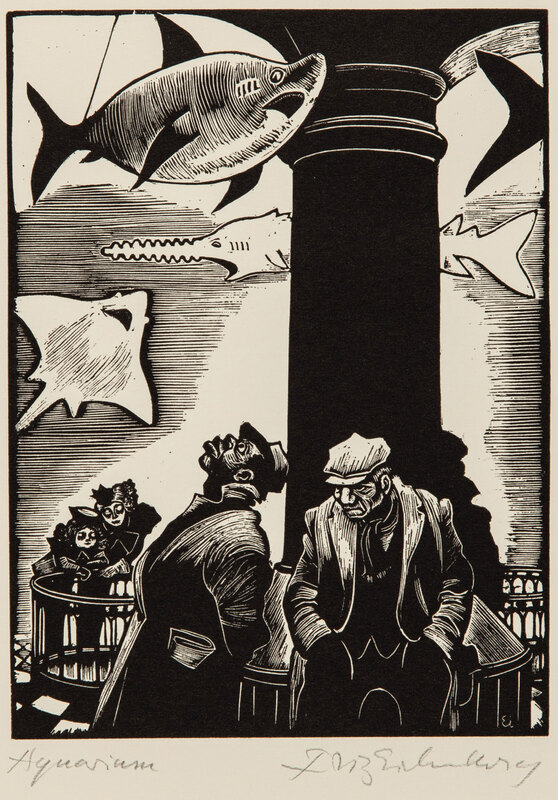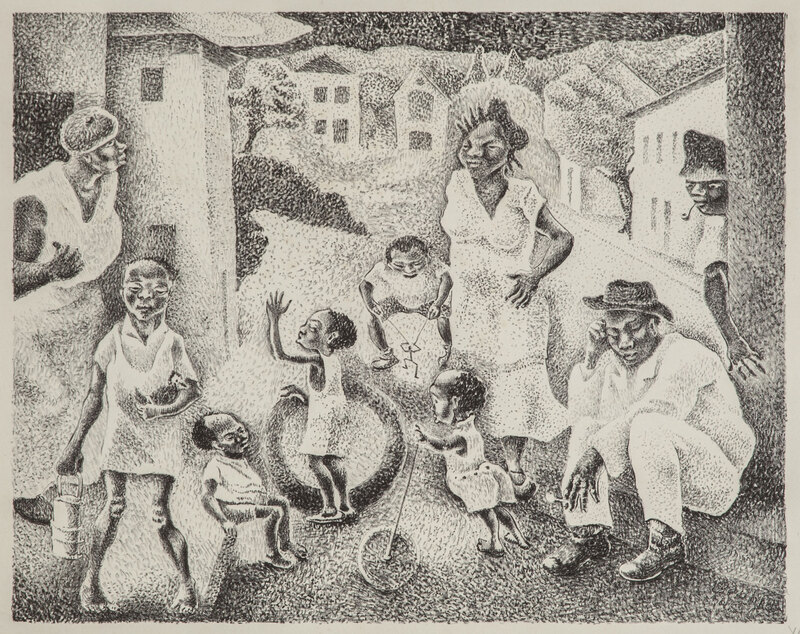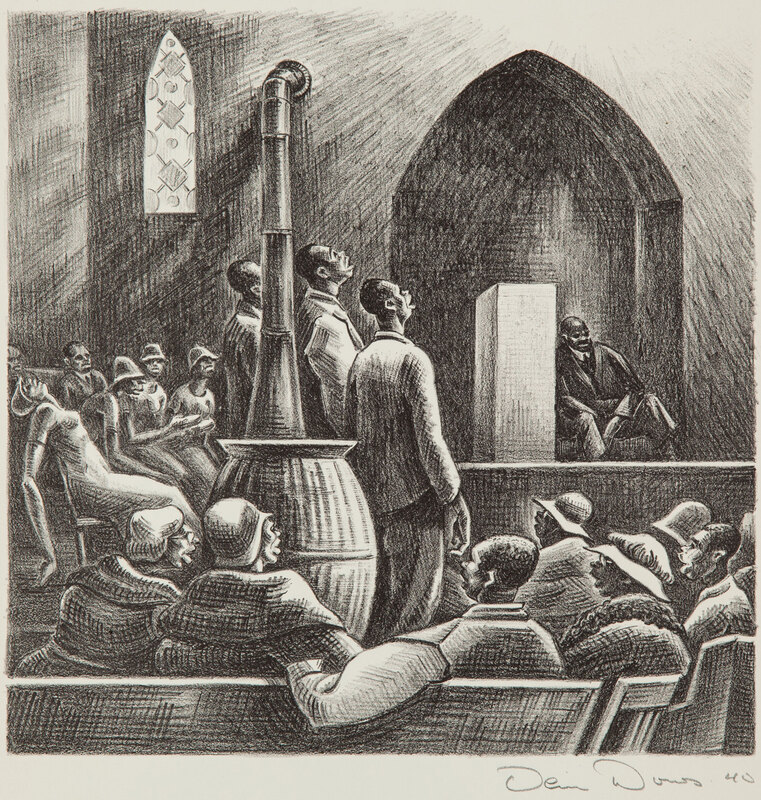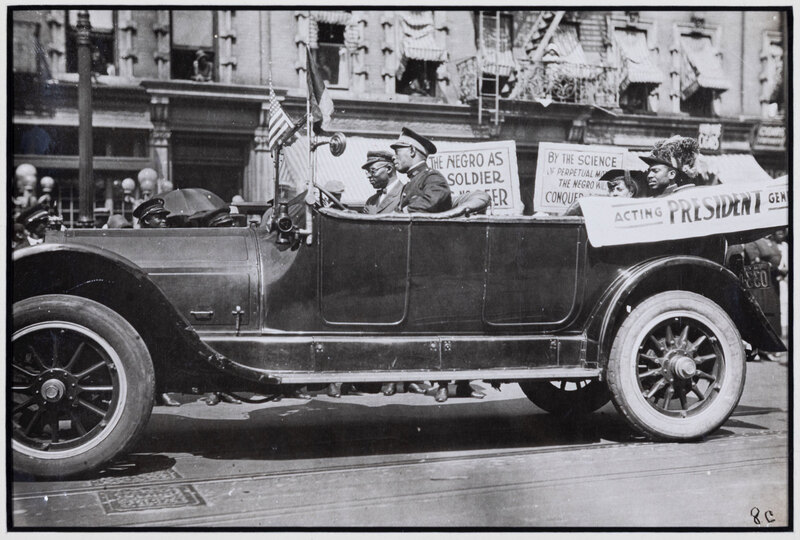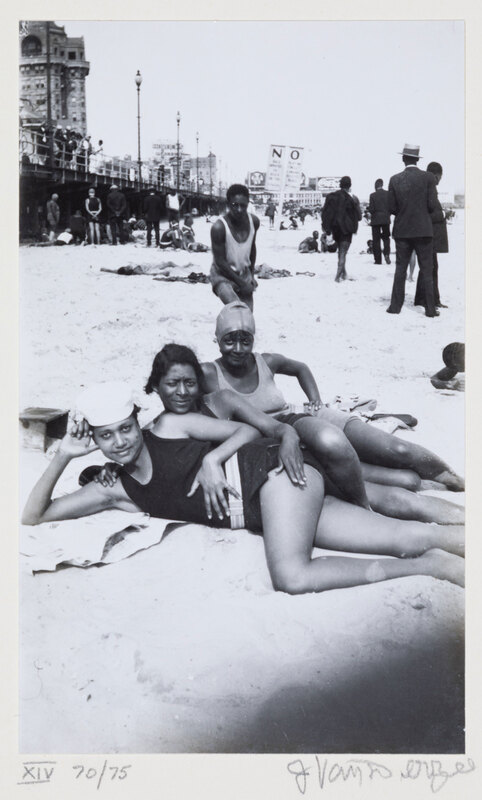Picturing Black Lives
The beginning of the twentieth century saw the movement of over one million African Americans from the rural South to the industrial North. This Great Migration brought opportunities, but also new hardships. Artists, both White and African American, increasingly depicted Black life in urban centers and other areas of everyday life.
The Great Depression was the greatest economic downturn in American history up to 1929; prior to Black Friday, that title belonged to the Panic of 1873, which inaugurated five long years of economic depression. In order to understand Black life in the 1930s, it’s useful to first consider how African Americans’ experience changed between those two downturns. In 1873, the majority of the Black population in the United States lived in the South, and many were formerly enslaved. Between 1867 and 1873, the South was controlled by the federal government as part of the post-Civil War Reconstruction. That changed in 1873—federal troops left the South, and Southern governments reasserted racially discriminatory laws. By the early 1900s, the Jim Crow system of segregation was firmly in place. Those few African Americans who had the financial means to leave the South often did, and the First World War accelerated this process. In what is known as the Great Migration, over one million Black Americans moved into Northern urban centers like Chicago, Toledo, and New York beginning in 1916 to work in war industries. While racial tensions led to the explosion of race riots in the Red Summer of 1919, this migration also spurred the development of a rich Black cultural movement called the Harlem Renaissance in the 1920s. During these years, the photographer James Van Der Zee, operating from his studio in the heart of Harlem, produced hundreds of pictures attesting to the social lives of the neighborhood’s middle-class residents. This fifty-year period thus brought new opportunities and new hardships to Black communities nationwide.
The Great Depression was no different. White Southern resistance to racial equality meant that most New Deal programs were closed to African Americans, and President Roosevelt did not pursue any anti-racist legislation, including an anti-lynching bill, that would have alienated the Democratic votes in the South that he needed to ensure the New Deal’s survival. However, Black artists did join New Deal art programs, which offered them the “cultural autonomy” that groups like the NAACP saw as important to securing racial equality. Black artists continued the tradition of the Harlem Renaissance and translated politics into art through their participation in the Federal Art Project, the Federal Writers’ Project, and the Federal Theatre Project.
As African Americans increasingly documented themselves in art, White artists also focused on Black life in the 1930s, portraying Black lives through White eyes. Many artists, based in New York City or other major urban areas, depicted the growing presence of African Americans in Northern cities. Other artists, in a desire to portray a fuller picture of America, traveled throughout the South and West, encountering Black communities in the process. Black lives became a particular focus for left-wing artists, who saw the treatment of African Americans as an important window into the contradictions of the national experiment.
––CCG
Fritz Eichenberg (American, born Germany, 1901 – 1990)
The Subway, 1934
wood engraving; 12 x 9”
Binghamton University Art Museum, 2016.4.219
gift of Gil and Deborah Williams
Fritz Eichenberg immigrated to New York City in 1933 from Germany and gained there a reputation for his masterful wood engraving techniques. He made this engraving shortly after his arrival in New York at the height of the Great Depression.
Eichenberg captured a diverse scene on a Seventh Avenue subway car, somewhere on its journey between Brooklyn and The Bronx. All of the passengers seem to be sleeping, save for a pious woman at the lower left hunched over her Bible. To her right a Black man dozes, perhaps following a long night’s work. At the center of the composition, a Black woman in hat and pearls naps while sitting upright, a posture that echoes her respectable choice of clothing. While not free of caricature, this print captures Eichenberg’s fascination with the racial diversity he found in his new home.
––CCG
Fritz Eichenberg (American, born Germany, 1901 – 1990)
Aquarium, 1934
wood engraving; 12 x 9”
Binghamton University Art Museum, 2016.4.218
gift of Gil and Deborah Williams
Interpretive text has not been prepared for this object.
George Biddle (American, 1885 – 1973)
Catfish Row, 1936
lithograph; 13 x 18”
Binghamton University Art Museum, 2016.4.106
gift of Gil and Deborah Williams
George Biddle first earned a degree from Harvard Law School before deciding to pursue an art career in 1911. He soon learned artmaking techniques in Philadelphia, Paris and Munich. After spending 1928 traveling Mexico with the influential muralist, Diego Rivera, Biddle adopted a social realist style.
This lithograph likely derives from Biddle’s collaboration with the composer George Gershwin (American, 1898 – 1937) on the opera Porgy and Bess (1935). Biddle had already traveled to Charleston, South Carolina in 1930, where the opera would be set, to study Black life. In 1935, his artwork appeared in the limited-edition libretto of Porgy and Bess. The title of the print, Catfish Row, comes directly from the opera. In it, we see five children playing games—one seems to play with a hoop, another with a marionette—in the company of four adults.
––CCG
Olin Dows (American, 1904 – 1981)
Untitled [Study for Easter Morning], 1940
watercolor; 14 x 8 ½”
Binghamton University Art Museum, 2016.4.161
gift of Gil and Deborah Williams
Interpretive text has not been prepared for this object.
Olin Dows (American, 1904 – 1981)
Easter Morning, 1940
lithograph; 13 ¼ x 14 ¼”
Binghamton University Art Museum, 2016.4.163
gift of Gil and Deborah Williams
Originally born in New York’s Hudson River Valley, Olin Dows developed his artistic skills at both Harvard and Yale, and in the late 1920s—like many future New Deal artists—traveled to Mexico where he met Diego Rivera (Mexican, 1886 – 1957). Dows was an important supporter of federal relief for artists and worked as the Director of the Treasury Relief Art Project in 1935. He frequently travelled to Washington, DC thanks both to his federal work and his personal friendship with President Roosevelt.
This growing familiarity with Washington is likely how Dows came to produce this lithograph, which depicts an Easter service in an African American church in the nation’s capital. Parishioners, dressed in their Sunday best, are seated around an iron stove singing a hymn, led by three men who stand at the center, gazing upward in song.
––CCG
Hugo Gellert (American, born Hungary, 1892 – 1985)
“Higher Mathematics,” from Comrade Gulliver, 1935
lithograph with letterpress plates; 23 ¼ x 16”
Binghamton University Art Museum, 2016.4.45
gift of Gil and Deborah Williams
Hugo Gellert’s family moved from Hungary to New York City in 1906, where he studied art and later went on to work for mainstream publications such as The New Yorker as well as leftist journals such as The Liberator. Gellert became an outspoken member of the Communist Party, and his political ideas appeared explicitly in his artwork.
“Higher Mathematics” is taken from Comrade Gulliver, which Gellert both wrote and illustrated. The portfolio, subtitled “An Illustrated Account of Travel into That Strange Country, the United States of America,” with its heavy criticism of America, especially its race relations, could be considered an updated, leftwing version of Gulliver’s Travels by Jonathan Swift (Irish, 1667 – 1745). Here Gellert depicts a Black man paging through a book. The text explains that this man, who studied mathematics in college, could only get work as a manual laborer due to his skin color. “America is a strange place indeed,” the text reads sarcastically. “They can afford to utilize mathematicians as carriers of luggage!”
––CCG
James Van Der Zee (American, 1886 – 1983)
Untitled (Marcus Garvey’s 1924 Demonstration Parade), 1924, printed ca. 1940
gelatin silver print; 5 x 7”
Binghamton University Art Museum, 2020.9.1
museum purchase with funds from Rebecca Moshief and Harris Tilevitz ‘78
Marcus Garvey (Jamaican, 1887 – 1940) arrived in New York in 1916, settling in New York and spreading his message of Black nationalism under the auspices of the Universal Negro Improvement Association (UNIA). The UNIA, whose influence touched millions of African Americans and members of the African diaspora throughout the English-speaking world, espoused a pan-Africanism that, in the face of resurgent racist violence, sought to unite all peoples of African descent. In Summer 1924, the UNIA held its fourth annual convention in New York, a month-long gathering that, in addition to meetings at venues such as Carnegie Hall, prominently featured grand parades. One such procession is captured in this photograph by James Van Der Zee, Harlem’s best-known photographer, whom Garvey had commissioned to document the proceedings.
Seated in a chauffeured limousine—with the American and red, green, and black African Republic flags affixed to the windscreen—is William LeVan Sherrill (American, 1894 – 1959), wearing a bicorne hat and identified on a banner as “acting president general” of the UNIA. Behind, placards held by parade-goers proclaim organization slogans: “The Negro as a soldier has no peer” and “By the science of perpetual motion, the Negro will conquer Africa.” Here, the greatest photographer of Black America in the early twentieth century documents the largest mass movement in African American history.
––TMD
James Van Der Zee (American, 1886 – 1983)
Atlantic City, 1930, printed 1974
gelatin silver print; 6 ½ x 4”
Binghamton University Art Museum, 2020.9.2
museum purchase with funds from Rebecca Moshief and Harris Tilevitz ‘78
In this playful photograph, three women lie on their sides, posing on the beach in Atlantic City, New Jersey. This seaside resort had developed as a popular destination beginning in the late nineteenth century and by the 1920s was dubbed by promoters as “the world’s playground.” However, not everyone was equally welcome to its ocean amenities; hotel owners at the end of the 1920s complained about growing numbers of African American visitors to the city’s beaches. Civic leaders responded by instituting a de facto segregated beach which would serve Black visitors until 1964, when the Civil Rights Act ended segregation in public places.
Van Der Zee captures three young women enjoying the fine weather at this beach. They look toward the photographer with expressions ranging from forthright to sardonic, as a young man strikes a sudden pose behind them. The strand is bustling with other African American visitors, but the famous Hotel Traymore, glimpsed in the photo’s upper left-hand corner just four blocks north, reminds us of the nearby world of White leisure forbidden to these women and photographer alike.
––TMD

